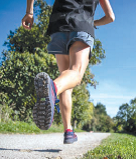 With the birds chirping and the sun making its debut in the horizon we see new life, new challenges, and new fitness goals. When that first peek of spring weather starts to surface runners who have been previously cooped up on their basement treadmills start to step out of the front door to start pounding the pavement. With that comes a slew of overuse injuries, foot aches and pains and tweaking knees. This article provides tips on how to keep yourself healthy so you can enjoy running over the long-haul.
With the birds chirping and the sun making its debut in the horizon we see new life, new challenges, and new fitness goals. When that first peek of spring weather starts to surface runners who have been previously cooped up on their basement treadmills start to step out of the front door to start pounding the pavement. With that comes a slew of overuse injuries, foot aches and pains and tweaking knees. This article provides tips on how to keep yourself healthy so you can enjoy running over the long-haul.
A 5-minute warm up and 5-minute cool down are CRUCIAL for the health and maintenance of your body. If your run starts as follows – open the front door, take a nice deep breath, go – you’re developing habits that can hurt you in the long term.
Your body should be primed and prepared for the demand you’re going to place on it prior to starting your run. Implementing a 5-minute dynamic warm-up is crucial to increase your body’s readiness for activity. A dynamic warm-up is an active set of movements you perform to warm up your entire body. Running affects not only the lower half but up the kinetic chain as well. Start with loosening the neck, shoulder and spine, then make your way to the lower half. A dynamic warm-up consists of fluid motion – unlike a static stretch program where you hold a position for an extended period of time.
There are studies that suggest a static stretching program may actually decrease your muscles’ ability to perform during exercise. With an appropriate dynamic warm-up routine your muscles should be ready to start moving through some running motions. This type of routine will also decrease the likelihood of muscle spasms, cramping, and minor aches and pains.
Conversely, your post-running program should consist of a static stretching program. This is when your muscles need to be elongated to allow for appropriate blood flow, decreased stiffness and also to flush out any stagnant lactic acid build up in the tissues which will cause soreness and fatigue the next day. If you are short on time or think ‘I just want to run I don’t care about all this other stuff’, think again. There are three crucial muscles to keep mobile and stretched – the calf muscles, hip flexor muscles, and the glute muscles. Stretching these three distinct muscles will help keep you on the running trail longer.
I hope these tips will keep you moving and running longer. I just started to get into running myself and as a Physical Therapist, it is easy to see how the repetitive motion can cause extra stress on your body. So please know these tips are based not only on science but also from experience. Keep Running!
Joseph Rendina is a Doctor of Physical Therapy and owner of Iron Health in Briarcliff Manor and Ardsley. You can reach him at 914-488-5763 or at www.ironhealth.co.







